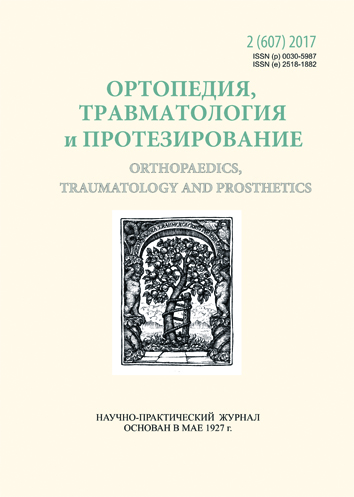External fixation device for closed treatment of metacarpal fractures
DOI:
https://doi.org/10.15674/0030-59872017292-96Keywords:
external fixation, metacarpal fractures, surgeryAbstract
For the treatment of closed metacarpal fractures bones designed external fixation devices, which allow closed reduction and fixation of fracture frafments. But rather complicated structure and large size limit their use.
Objective: to present external fixation device and treatment technology of closed displaced metacarpal fracture.
Methods: treatment with the proposed external fixation device conducted in 21 patients (2 women and 19 men, age 15 to 46 years) with closed displaced metacarpal fractures. II metacarpal bone fracture was found in 4 patients, IV — 9, V — 7, while IV–V — in 1. All patients previously underwent unsuccessful attempts of closed reposition.
Results: the apparatus consists of a basic and mobile pin-holders, threaded distractor and two connecting rods. Reduction device is a separate pin-holder with holes for directing and rods, clamping screws, penetrating smooth cylindrical hole in which freely passes distractor. After 2 holes in the base of pin-holder the proximal metacarpal bone fragment inserted two threaded rod and the proximal phalanx through hole of reduction pin-holder — usually one. To carry out distraction by 2–3 mm per day. Due to ligamentotaxis fracture is selfreduced. If the reduction achieved, the 2–3 hole in a moving pin-lock distractor of distal metacarpal bone administered 2–3 pins perform moderate compression and radiological control. In 14 cases achieved anatomic reposition of fragments. In 6 patients observed acceptable position. All patients in terms of fractures healed 3–5 weeks.
Conclusions: the proposed external fixation device allows closed reduction and fractures fixation of metacarpal bone of any kind of displacement.
References
- Day ChS. Wolfe SW, Hotchkiss RN, Pederson WC, et al. Fractures of the metacarpals and phalanges. Green’s operative hand surgery [eds.]. 7th ed. Philadelphia, PA: Elsevier, 2017. рр. 231-77.
- Wall LB, Stern PJ. Metacarpal and phalangeal shaft fractures. Operative orthopedics of the upper extremity. New York: McGraw-Hill Education, 2014. рр. 3–11.
- Kolontay IuIu, Naumenko Liu, Miloslavskii FA, Golovakha ND. Surgery of hand injuries. Dnipropetrovsk: Porogi, 1997. 460 p. (in Russian)
- Shveed SI, Glukhov DV, Novichkov SI. Device for osteosynthesis of short tubular bones of the hand. Genius of orthopaedics. 2002;(3):126-27. (in Russian)
- Andrucon MV, Goloborodko SA. Use of the external fixation device in the treatment of hand injuries. Orthopadics, Traumatology and Prosthetics. 1989;(7):37-9. (in Russian)
- Shikhaleva NG, Chirkova IV. Treatment of patients having close fractures of distal metaepiphysis metacarpal bones with transosseous osteosynthesis. Genius of orthopaedics. 2009;(2):40-5. (in Russian)
- Arunachalam S, Shanmugavelu M, Chellappa E, Arunachalam S. Prospective study of external fixators in fractures of hand. Indian J Applied Res. 2016;6(5):490-5.
- De Kesel R. Burny F., Schuind F. Mini external fixation for hand fractures and dislocations: the current state of the art. Hand Clin. 2006;22(3):307-15. doi: 10.1016/j.hcl.2006.02.014.
- Margic K. External fixation of closed metacarpal and phalangeal fractures of digits. A prospective study of one hundred consecutive patients. J Hand Surg Eur. 2006;31(1):30–40. doi: 10.1016/j.jhsb.2005.09.013.
Downloads
How to Cite
Issue
Section
License
Copyright (c) 2017 Sergey Goloborodko

This work is licensed under a Creative Commons Attribution 4.0 International License.
The authors retain the right of authorship of their manuscript and pass the journal the right of the first publication of this article, which automatically become available from the date of publication under the terms of Creative Commons Attribution License, which allows others to freely distribute the published manuscript with mandatory linking to authors of the original research and the first publication of this one in this journal.
Authors have the right to enter into a separate supplemental agreement on the additional non-exclusive distribution of manuscript in the form in which it was published by the journal (i.e. to put work in electronic storage of an institution or publish as a part of the book) while maintaining the reference to the first publication of the manuscript in this journal.
The editorial policy of the journal allows authors and encourages manuscript accommodation online (i.e. in storage of an institution or on the personal websites) as before submission of the manuscript to the editorial office, and during its editorial processing because it contributes to productive scientific discussion and positively affects the efficiency and dynamics of the published manuscript citation (see The Effect of Open Access).














